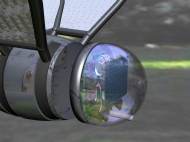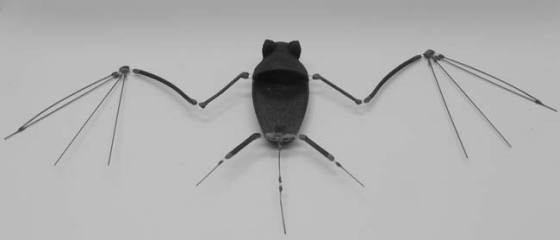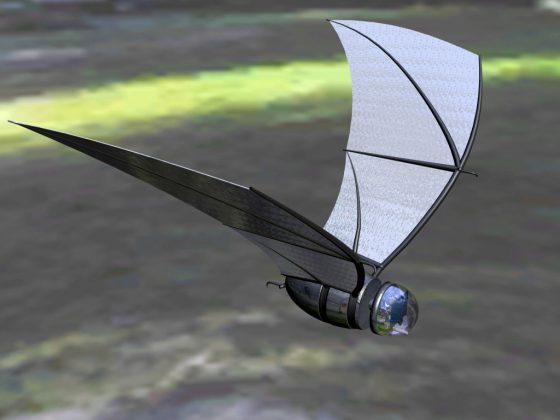Robotic spies – bat biomimicry
 We already wrote about potential surveillance micro-aerial vehicles in our previous articles. Small flyers, or micro-aerial vehicles (MAVs), have garnered a great deal of interest due to their potential applications where maneuverability in tight spaces or in stealth requiring conditions. In this article we’re going to write about two researches related to the biomimicry of bats. The researchers at North Carolina State University concentrated on the development of robotic bats that offer increased maneuverability and performance while the researchers from University of Michigan focused on the sensors and communication issues.
We already wrote about potential surveillance micro-aerial vehicles in our previous articles. Small flyers, or micro-aerial vehicles (MAVs), have garnered a great deal of interest due to their potential applications where maneuverability in tight spaces or in stealth requiring conditions. In this article we’re going to write about two researches related to the biomimicry of bats. The researchers at North Carolina State University concentrated on the development of robotic bats that offer increased maneuverability and performance while the researchers from University of Michigan focused on the sensors and communication issues.
Gheorghe Bunget, main researcher from the NC State, said, “due to the availability of small sensors, MAVs can be used for detection missions of biological, chemical and nuclear agents.” But, due to their size, devices using a traditional fixed-wing or rotary-wing design have low maneuverability and aerodynamic efficiency.
The researchers did extensive analysis of bats’ skeletal and muscular systems before developing a “robo-bat” skeleton using rapid prototyping technologies. The fully assembled skeleton rests easily in the palm of your hand and, at less than 6 grams, feels as light as a feather. The researchers are currently completing fabrication and assembly of the joints, muscular system and wing membrane for the robo-bat, which should allow it to fly with the same efficient flapping motion used by real bats.
Smart materials are also being used for the muscular system explains Bunget’s advisor, Stefan Seelecke: “We’re using an alloy that responds to the heat from an electric current. That heat actuates micro-scale wires the size of a human hair, making them contract like ‘metal muscles’. During the contraction, the powerful muscle wires also change their electric resistance, which can be easily measured, thus providing simultaneous action and sensory input. This dual functionality will help cut down on the robo-bat’s weight, and allow the robot to respond quickly to changing conditions – such as a gust of wind – as perfectly as a real bat.”
In addition to creating a surveillance tool with very real practical applications, Seelecke says the robo-bat could also help expand our understanding of aerodynamics. “It will allow us to do tests where we can control all of the variables – and finally give us the opportunity to fully understand the aerodynamics of flapping flight,”
University of Michigan researchers will focus on the microelectronics. They will develop sensors, communication tools and batteries for their micro-aerial vehicle. Engineers envision tiny cameras for stereo vision, an array of mini microphones that could home in on sounds from different directions, and small detectors for nuclear radiation and poisonous gases. A six-inch robotic spy plane modeled after a bat would gather data from sights, sounds and smells in urban combat zones and transmit information back to a soldier in real time.
Low-power miniaturized radar and a very sensitive navigation system would help the bat find its way at night. Energy scavenging from solar, wind, vibration and other sources would recharge the bat’s lithium battery. The aircraft would use radio to send signals back to troops.
“These are all concepts, and many of them are the next generation of devices we have already developed. We’re trying to push the edge of our technologies to achieve functionality that was not possible before,” said Kamal Sarabandi, from the U-M Department of Electrical Engineering and Computer Science.
“Bats have a highly-attuned echolocation sense providing high-resolution navigation and sensing ability even in the dark, just as our sensor must be able to do,” Sarabandi said. Echolocation allows real bats to navigate by emitting sounds and detecting the echoes. The bat robot’s body would be about six inches long. It would weigh about a quarter of a pound and use about 1 W of power.
U-M researchers intend to improve on current technologies. They’ll work to develop quantum dot solar cells that double the efficiency of current cells. They expect their autonomous navigation system, which would allow the robot to direct its own movements, to be 1,000 times smaller and more energy efficient than the systems used now. They believe they can deliver a communication system that’s 10 times smaller, lighter and more energy efficient than today’s technologies.











Excellent peice showing great strides in Biomimicking.
Dr.A.Jagadeesh Nllore(AP),India